Over the last ten years or so, Montefalco has captured the attention of wine lovers in Italy and increasingly so everywhere, thanks to a bevy of classically dry white and red wines, plus its standout passito (air-dried) sweet red wine.
In fact, while the Montefalco denomination has long been most famous for its Montefalco Sagrantino red wine, which represents Umbria’s (theoretically) most exciting and sought-after wine, the fact is that the area is actually becoming increasingly interesting because of its lovely and very interesting white wines and lighter-styled reds that act as welcome counterpoint to the massively tannic and structured behemoths made with the Sagrantino variety. In fact, the area’s Passito sweet red Sagrantino wine is one of Italy’s better sweet wines. In other words, wine lovers everywhere have plenty to choose from when it comes from the Montefalco neck of the Italian woods.
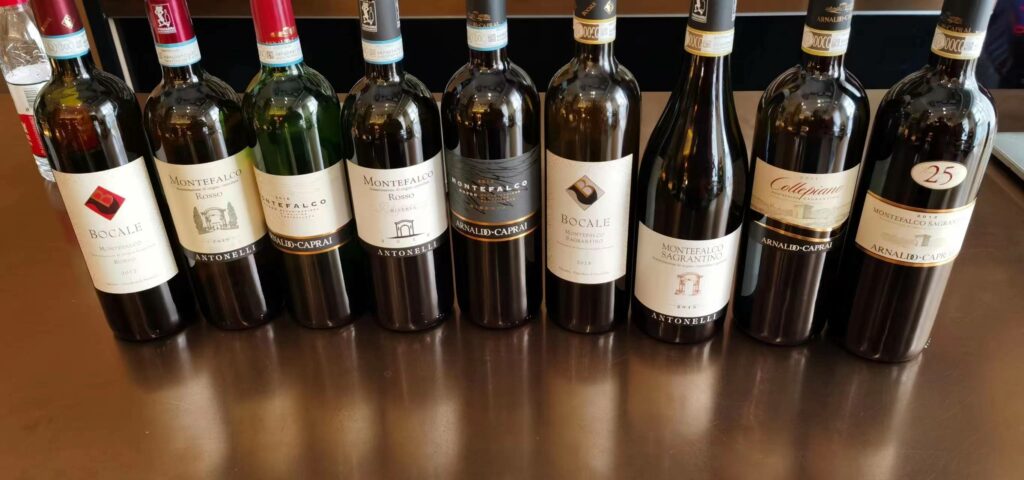
The grape varieties and wines of Montefalco
Although I have written countless times on this subject before, it never hurts to quickly review the grapes with which Montefalco’s wines are made as they are, for the most part, highly typical of the area and heavily characterize its wines. I’ve said it before and I will say it again: unless you know Italy’s wine grapes, and know them well, there is no point in trying to understand Italian wines. And to be crystal-clear about this, for those who like to write and score wines, to do so by applying Cabernet Sauvignon and Chardonnay-tainted standards of judgement because one doesn’t really know or have experience with anything else, is not just wrong, it’s pointless and downright unfair. A Grechetto or Trebbiano Spoletino wine cannot and above all should not give you the same sensations as an oaked, ultra-buttery ripe Chardonnay wine: if you penalize one of those two Italian wines because it doesn’t taste like the Chardonnay wines of that style you may have cut your teeth on, then the problem is not really with the wines, frankly. For more information on the specific grapes of Montefalco, what they are about and what you should expect them to give (and what not to give), I refer anybody who might wish to know more about, or is just interested in, the subject to my two award-winning books: Native Wine Grapes of Italy (University of California Press) and the abridged, easier-to-read but less in-depth The Grapes and Wines of Italy: the Definitive Compendium Region by Region (Amazon Press).
Recently, Montefalco has seen a slight change put into effect concerning the grape variety guidelines for production of some of the area’s wines. The grapes remain the same, but their percentage regulations change slightly. Montefalco’s production of white wines is fairly minimal: these are the Montefalco Grechetto (that starting with the 2016 vintage has to be made with a minimum of 85% Grechetto varieties); the Montefalco Bianco, a blend of Grechetto and Trebbiano Toscano (that with the 2016 vintage has to be made with at least 50% Trebbiano Spoletino); and the more interesting Trebbiano Spoletino wines, yet another of the many Italian native grape and wine success stories of the last twenty years. Of those three, it is the Grechettos and Trebbiano Spoletino that are typical of Montefalco and Umbria, while Trebbiano Toscano grows almost everywhere in the country (it is in fact Italy’s second most planted wine grape). The white grapes of the Montefalco area are mostly the Grechetto varieties (there are two) and Trebbiano Spoletino. The ‘Grechetto’ name is an old one and used already in ancient Rome; it derives either from a presumed Greek origin of the grape or from wines that were made in the “Greek style”. An extremely important group of varieties in Umbria, mostly associated with the production of Orvieto wine (up until the 1970s one of Italy’s two or three most famous white wines), the two Grechettos are Grechetto di Orvieto (or true Grechetto) and the Grechetto di Todi, which is in reality Emilia Romagna’s Pignoletto grape that has adapted over the centuries to the Umbrian countryside. So, in the eventuality that we are discussing old vines of Grechetto di Todi, that have lived and adapted to the Umbrian countryside for decades and decades, then it is neither wrong nor unreasonable to view the grape as a specific Umbrian biotype of Pignoletto that gives different wines from those of Emilia -Romagna. In this case, it can be called Grechetto di Todi. Clearly this is not possible if and when someone just picks Pignoletto from a nursery and plants it in the Montefalco area saying it’s “Grechetto di Todi”. In this case, It is so in name only, because in that case that’s nothing but Pignoletto, pure and simple; and that’s because the grape has not yet lived and adapted long enough (for decades and decades minimum) in and to a specific Umbrian subregion.
The Grechetto varieties look very different from one an another and are easy to distinguish in the vineyard; you just need to go, take a look and commit their look to memory. Furthermore and most importantly, their wines are rather different too. Both boast aromas and flavours of yellow apple, lime, lemon, pear, white flowers, and chamomile. However, and generalizing somewhat, those made with Grechetto di Todi tend to be a bit more full-bodied (even tannic, given the thick skins, so it depends on what the producer chooses to do), while those made with Grechetto di Orvieto tend to be lighter-styled, higher in acidity and more nuanced in their aroma and flavour profiles.
Trebbiano Spoletino is a variety that was essentially unheard of until 2010 or thereabouts; it has since had skyrocketing success and represents yet another of the many positive, feel-good native wine grape variety stories to have emerged out of Italy in the last twenty years. Just imagine that only twenty to twenty-five years ago hardly anyone in the country outside of immediate drinking circles knew anything about grapes such as Etna’s Nerellos and Carricante, Abruzzo’s Pecorino, and Puglia’s Uva di Troia; and even fewer wines were available. The same goes for Trebbiano Spoletino: but like it was for those high-quality grapes, once it became apparent just how good Trebbiano Spoletino wines could be, the grape variety took off, so much so that it is now starting to supplant the Grechettos in the Montefalco area, at least in terms of rising popularity. Trebbiano Spoletino is grown only in Umbria, especially in the townships of Spoleto, Montefalco, and the many small towns in the area. But despite its Trebbiano-something name, Trebbiano Spoletino bears no relation to any of the other similarly-named grape varieties (the only Trebbiano variety with which it does have a small relationship is Trebbiano Abruzzese, not by chance the other high quality Trebbiano variety in that large group). Very vigorous and productive, it behaves like all other Trebbianos, in that it is a late ripener and is marked by generous acidity levels; that said, there appears to be large intravarietal variability with this grape, especially among the older vines. It is likely that not all the grapes in the Montefalco area being called Trebbiano Spoletino are really all Trebbiano Spoletino: that much is easy to guess given that wines can range from fresh and lemony, with Sauvignon-like characters, to unctuous and alcoholic, with a few bordering on the aromatic in a Muscat Bianco-like sort of way. It follows that outside of enological alchemy, the grapes used to make those wines are probably altogether different (some Trebbiano Spoletino wines are made in a macerated style, but that’s a consequence of stylistic producer preference).
Sangiovese in Umbria was long the most important red grape, and it still is an important part of just about most of the region’s red wine denominations, the best-known of those being the wines of Torgiano (Torgiano Rosso and Torgiano Rosso Riserva). In Montefalco, Sangiovese plays an important role too: for while the main player for the denomination is undoubtedly Sagrantino and its Montefalco Sagrantino wine, Sangiovese is the main player in the Montefalco Rosso and Montefalco Rosso Riserva blends. For the longest time, these two red wines were treated as an afterthought by many local producers, who focused all their attention and energy on making the best (and biggest, usually) Sagrantino wine possible. But in time it became apparent that many of the Montefalco Rosso and Montefalco Rosso Riserva wines were actually really potentially lovely wines, offering a completely different, and far more drinkable, quaff than Sagrantino’s. The thing to remember about these two wines is that, unlike in Tuscany, where the entry-level Rosso di Montalcino and Rosso di Montepulciano wines are essentially lighter-bodied replicants of the much bigger and age-worthy top-tier reds of their respective denominations (Brunello di Montalcino and Vino Nobile di Montepulciano), Montefalco Rosso and Montefalco Rosso Riserva are in fact completely different wines from Montefalco Sagrantino. In other words, they are NOT 100% Sagrantino wines as is the wine called Montefalco Sagrantino. Once again now: whereas Rosso and Brunello di Montalcino are both 100% Sangiovese wines, with Montefalco things are not so: Montefalco Sagrantino is a 100% Sagrantino wine, but Montefalco Rosso and Montefalco Rosso Riserva are actually blends of Sangiovese, and/or Sagrantino, Montepulciano and Merlot (usually), with Sagrantino often playing a really minor role in the blend (but starting with the 2016 vintage, the wine will have to be made with a blend of Sangiovese (60-80%), Sagrantino (10-25%), and other authorized grapes (15-30%). It follows that more than with other Italian red wine denominations, Montefalco offers very different red wines that appeal to a broad and highly diverse wine loving public. It is no small stroke of luck or advantage that, in recent times, both the Montefalco Rosso and Montefalco Rosso Riserva have become very worthy wines in their own right (the biggest difference between the two wines is usually the length of oak aging). I cannot stress to you enough how much it is worth your while to give these two wines a chance. While many less successful Sagrantino wines are so tannic that they border on the unpleasant (and no amount of cellaring will subdue those often far too gritty tannins), well-made Montefalco Rosso and Montefalco Rosso Riserva (ie. not oaked to death) are remarkably good buys and very food-friendly. Believe you me, there is a lot to like (potentially) in those two wine categories.
Last but not least, Sagrantino gives what is probably one of Italy’s two most tannic red wines. The name Sagrantino is believed to derive either from sagra (feast), since the wine was almost always sweet and drunk mainly on holidays and other festive occasions, or from sacrestia (or “sacristy”, in English, a reference to Sagrantino’s wines being used in the officiation of the Mass). Or you can believe the legend that Emperor Frederic II had a sick hunting falcon (saccr) that was cured by treatment based on a medical potion containing Sagrantino, and hence the wine’s name.
There are several nursery clones of Sagrantino that look and behave differently, but for the most part Sagrantino is characterized by medium-small, cylindrical to conical-cylindrical, rather loosely packed bunches. It’s not an especially productive variety that needs plenty of sun and heat to ripen properly, otherwise its wines will be unfailingly marred by strong vegetal streaks and impossibly gritty tannins. These are also very inky-coloured wines (the exact antithesis of pure Sangiovese and Nebbiolo wines that are relatively pale red in colour), that smell and taste of black cherry, blueberry, blackberry, aromatic herbs, tobacco cocoa, earth and flint. A DOCG since 1992, the Montefalco Sagrantino production zone includes the communes of: Montefalco, Bevagna, Castel Ritaldi, Giano dell’Umbria and Gualdo Cattaneo. Much as it is in Bordeaux with the wines of Margaux and Pauillac or in Burgundy with the wines say of Volnay and Pommard, there are clear-cut differences in style between Sagrantino wines made in different areas of the production zone; but recognizing these differences depends on the estates growing their grapes only in one zone (usually it’s the case, especially with smaller producers). Along general guidelines, the Sagrantino wines of Montefalco are more structured yet refined, those of Bevagna more floral, while those of Castel Ritaldi and Gualdo Cattaneo are softer and are accessible earlier on in their lives. (For more information on the specific terroirs of the various Montefalco denomination’s communes, I refer you to my Italy’s Native Wine Grapes Terroirs book, published by University of California Press and detailing to an extent like never done before the specific terroirs of Montefalco and how they translate into the wines.)
If you are planning to visit the Montefalco area anytime soon (Montefalco and especially Bevagna are two of Italy’s prettiest and best-kept medieval towns and they are very much worth a visit), there are many very good estates you can visit, all of which have something to offer. A good selection by which to begin is these names I recommend you here: go visit Adanti, Arnaldo Caprai, Antano Milziade, Antonelli-San Marco and Bocale, as these will give you a thorough knowledge base and understanding of both the older and more traditional style of Montefalco wines as well as the more modern and forward-thinking style. Furthermore, these estates will not only give you the opportunity to taste some of the areas best wines, but also a chance to study the differences there are in Montefalco’s wines (the wines of Adanti are made in a subregion that is completely different from Caprai’s, for example). These are must visits if you are ever in the area: if you have a little more time, then I would also also add Lungarotti and Tenuta Castelbuono to the list. Both of which make excellent wines too, and the latter is also one of the more singular and beautiful wineries you will ever see in Italy.
Recent vintages
The 2020 vintage in the Montefalco area was characterized by a growing season that was just ideal at its start and in middle (as in there was no shortage of dry and warm conditions) but then by noteworthy showers before and during the harvest. For this reason, 2020 is considered by locals to be an especially good vintage for earlier-ripening varieties such as the Grechettos and a little less successful for the later-ripening ones such as Trebbiano Spoletino and Sagrantino. Clearly, a good amount of the success individual producers will have had in 2020 will depend on their individual viticultural practices (for example, judicious deleafing and airing out the bunches were probably necessary steps to have taken in 2020, and those who didn’t engage in the necessary amount of manual labour and expenditure of energy, well…). Everyone of course will tell you that the year was just fine and everything was dandy, but the fact remains it started raining the last ten days of September and that neither Trebbiano Spoletino nor Sagrantino are normally optimally/fully ripe by then. Overall, there was a 20% decrease in production yields. Nevertheless, it is only fair to say that what 2020 white wines I have tried are excellent. The 2019 vintage also saw a decrease in volumes produced (Confagricoltura estimated a 13% drop in production compared to 2018) mostly due to problems related to flowering. While the first part of the growing season went off uneventfully (budding was in the norm), flowering was hampered by copious rain and cold weather hitting hard in May, both delaying and reducing it (it finally took place at end of May for the early-ripening varieties and as late as mid-June for the late-ripening ones). Véraison (the colour change of the grapes) was also delayed by about a month, but the intense July heat (at least in this regards, the intense early season rainfall proved beneficial given that the built-up soil water reserves came in very handy during the droughty and hot summertime) brought the growth cycle back into the norm of yearly averages.
Though many you will hear and read on the subject will wax on poetically about the greatness that the 2018 vintage was or will turn out to be for the area’s wines, the fact is it should be remembered as a generous year that is good to very good, but not great. It was actually a better vintage in Montefalco than in many other parts of Italy, in a poignant reminder that generic vintage charts are really of little use. For sure, the 2018 white wines were fresher and lighter-styled than the almost too big 2017s; drunk over the short term, they made for some excellent quaffs indeed. The 2018 growing season got off to a late start throughout Italy (especially in central Italy), with a rainy and cold spring setting an early tone, but the Montefalco denomination’s topography and location meant it escaped some of the worse weather-related events of the vintage. So it is that when the clouds arrive in Umbria, and rain too, world-famous, beautiful cities such as Assisi and Foligno get drenched, but the Montefalco territory sees very little of that liquid hits its ground. And Bevagna is usually even drier than Montefalco. For example, comparing Bevagna’s territory to Montefalco’s during the same time period, in Bevagna there were only three days of rain (about 30 millimeters in three months), while over in Montefalco there were instead 45 millimeters in five different episodes. Still, not much compared to the averages of other central Italian viticultural zones. I may be wrong, but I think Sangiovese, at least locally, did very well for itself in this vintage.
The 2017 vintage was just as difficult in Montefalco as it was almost everywhere else in Italy. That it was just too hot is clearly demonstrated by the fact that many Montefalco estates finished picking their Sagrantino grapes at the end of September, unheard of for this normally late-ripening grapes. Fortunately, a little, sporadic rainfall appeared on the scene in the latter part of September, which allowed estates to leave grapes in the vine a little longer and get better hang time, which with Sagrantino, given its tannic heft, is just about vital. Clearly, the better estates were quick to adjust their winemaking in response to the weather conditions, so as to for example reduce punching-down frequencies and just about anything that might have led to increased extraction levels. The 2017 vintage will be remembered for an extremely small crop (as much as 35-40% less in some parts of the denomination and Umbria), and substantial levels of tannins and alcohol by volume. It’s a vintage in which the better winemakers will shine, and the better viticulturists even more. The 2016 is a classic vintage and one that will be marked by potentially great, long-lived wines. A fresher year than most, it marked a return to the classic years of the 1980s and early 1990s, with wines marked by youthfully chewy but noble tannins. The wines are generally more lifted than the broader, more massive 2015s. The 2015 vintage is another excellent one for the area. It featured a rainy winter and windy spring but with lots of sunlight. Summer was fairly warm and dry and there was adequate rainfall in the summer allowing for the replenishment of water reserves. Locals believe this to be a great vintage and I would say that, for the most part, they are probably not wrong in their assessment.
The wines in this tasting report
Adanti.
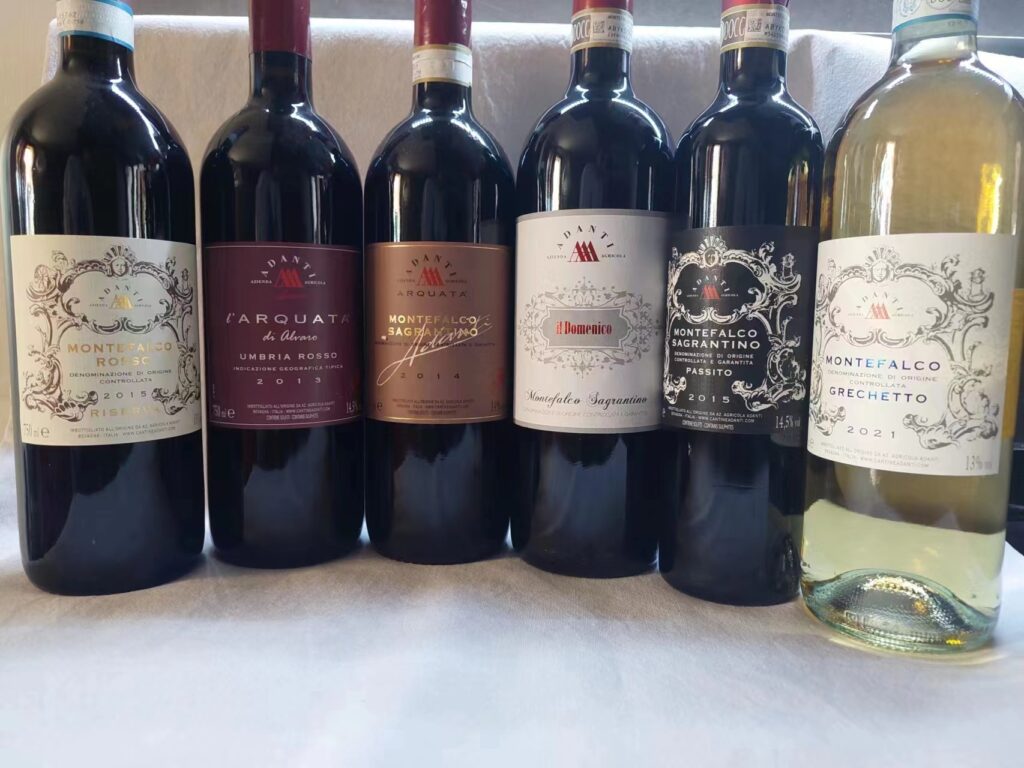
Domenico Adanti really believed in Sagrantino’s worth and potential and was the first to push the area’s wines in a modern commercial sense (after sll, he was one of the first three producers of Sagrantino wine after Enopolio and Tardioli). And so its is that the Adanti farm is one of the historic cellars of the Montefalco area, a particular subregion of the denomination that is known as Arquata. Arquata is characterized by lower pH soils, and wines that, not surprisingly, have a brighter acid bite and are more politely styled and graceful on the palate than most other Sagrantino wines. In fact, the estate and its production zone are also much-admired for their lighter-styled Montefalco Rosso. The estate is now owned and run by Donatella and Daniela Adanti: it’s forty hectares large, of which about thirty are under vine and the remaining ten hectares grow olive trees. Just about any wine you’ll taste from Adanti, be it the whites, the classically dry reds, or the sweet Passito, will be at the top of the quality heap. I have said and written this before, and nothing has happened to since change my mind: simply put, for my money and my taste buds, Adanti is one of the three best estates in all Montefalco and their wines are not just gems but benchmarks of the denomination. In fact, if you really pinned my back to the wall and forced me to pick one Montefalco estate only, the wines of which I’d want on a desert island, well…it’s this one. Montefalco wines just don’t get any better than Adanti’s, and their range of wines is, at least for my money, the best of the denomination.
Adanti 2021 Montefalco Grechetto 89
Bright pale yellow. Subtle citrus fruits and herbs on the fresh, lively nose. Juicy and vibrant in the mouth, showing a ripe quality to its fruit flavours but also plenty of framing energy. Hints of peach and of ginger display good depth and a spicy edge. Closes nicely dry and stony. Very easy-going wine brimming with early appeal ideal for uncomplicated drinking; inexpensive and good as a wine by the glass number. Drinking window: now-2023.
Adanti 2016 Montefalco Rosso 91
Lively ruby-red colour. Strawberry, red cherry and violet on the nose complemented by tobacco and licorice. Then similar flavours to the aromas, with polished tannins providing support on the long back end. This refined entry-level wine has a lot more stuffing than one would expect at this price point; lovely 70% Sangiovese, 15% Sagrantino, 5% Barbera, 5% Cabernet Sauvignon, 5% Merlot made from grapes grown at about 230 meters above sea level in and around the area of Bevagna. Drinking window: now-2024.
Adanti 2015 Montefalco Rosso Riserva 91+
Good full ruby. Black- and redcurrant aromas on the nose are spiced up by licorice and cocoa. Enters fairly sweet and plush, with dark plum, truffle and mineral flavours enlivened by harmonious citrussy acidity. Very complex Rosso Riserva and lighter on its feet than most, in the typical, elegant Adanti wine style. A 70% Sangiovese, 15% Sagrantino, and 15% Merlot blend aged for about thirty months in oak barrels. Drinking window: now-2015.
Adanti 2014 Montefalco Sagrantino 92
Fully saturated ruby. Brooding but vibrant aromas of blackberry, plum, licorice, graphite and herbs. Densely packed, seamless and intense, with deep flavours of blackberry, juniper berries, candied violet and bitter chocolate nicely lifted by an obvious herbal component. Displays excellent life and length on the vibrant aftertaste. Made from two vineyard plots in Bevagna (one plot in the subregion of Arquata facing north-west on clay-calcareous soil at about 360 meters above sea level and one in Colcimino, west-facing on clay-sandy-calcareous soil at about 250 meters above sea level), and a plot in Montefalco (in the subregion of Campoletame, southeast-facing on clay-sandy-calcareous soil at about 250 meters above sea level). Drinking window: now-2028.
Adanti 2009 Montefalco Sagrantino Il Domenico 93
Ok, now we’re talkin’! This big boy is hitting on all cylinders right now: Moderately saturated ruby-red, offering an open-knit in your face nose of blackberry, cassis, licorice, violet and cocoa complicated by hints of potpourri. Layered and thick but fresh, with a firm acid spine providing the fine-grained, generous texture and ripe fruit and herbal flavours more than adequate support. Finishes with noteworthy chewy tannins but polished and impressive length. Drinking window: now-2030.
Adanti 2015 Montefalco Sagrantino Passito 94
Deep red-ruby. Deep, brooding nose combines exotic orange oil, red cherry and milk chocolate; perfumed but quite fine. Then at once opulent and silky, with harmonious acidity neatly underscoring the purity of the red fruit, mocha and nutmeg flavours. This seemed to grow thicker after a minute or two in the glass, with an inviting saline soil character adding further complexity and building on the long suave finish. Drinking window: now-2035.
Antano Milziade.
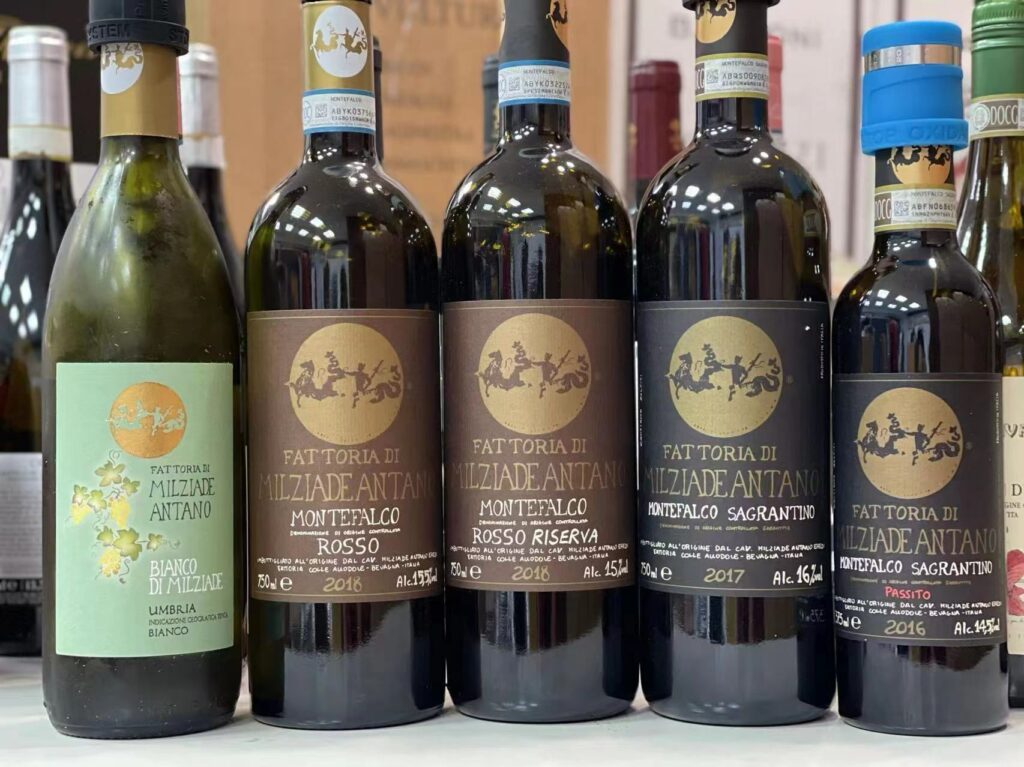
Francesco Antano is a super-talented guy and his wines are amongst the best of the whole Montefalco denomination; and if you were to tell me you thought he made the best Sagrantino wine of all, I’d have nothing to object. In fact, Antano Milziade makes the best Sagrantino wine of the denomination; and while his Montefalco Rosso ised to be affected by gamey and funky smells that had me once avoiding it, things have improved to the point that this is no longer the case. Still, the wines are made in a richer, broader, more evolved style than most. They also taste of Sagrantino and Sangiovese, not of Cabernet and Merlot, and for those who like that, it’s something worth noting right there: these are not flinty, cool, mineral wines that could perhaps be made elsewhere, they speak insetad of the hills of Bevagna and Montefalco, and I for one like that (though I totally understand why adding Merlot, a much suppler grape than Sagrantino, will really help the drinkability of a Montefalco Rosso or Montefalco Rosso Riserva). Milziade’s farm is called Colleallodole (the hill of the larks) and he uses the “Colleallodole” name to indicate the single-vineyard top of the line Sagrantino wine he makes. His is really a very small, garagiste-style reality. Antano is an “old school”-style winemaker, who keeps his interventions in the cellar to the bare minimum, avoids barriques and has no high-tech equipment of any kind. He green harvests aggressively and has very low yield, producing what are some of the most suave, fleshy and round Sagrantino wines of all. Think of these as the Clape, Rayas or Bartolo Mascarello wines of Montefalco.
Antano Milziade 2020 Umbria Bianco Bianco di Milziade 90
Lively straw-yellow. Apple blossoms and spiced pear on the nose. Juicy and ripe, with noteworthy fat and lift, closing with lovely fruity sweetness and good grip. Easygoing accessible and fun to drink. Drinking window: now-2024.
Antano Milziade 2018 Montefalco Rosso 92
Bright red-ruby. Lovely violet lift to the aromas of blackberry, licorice, chocolate and sexy oak. Plush, fine-grained and sweet, with bright flavors of musky red cherry and herbs. Finishes long and with an edge-free texture. This is Antano’s most imprtoved wine: while it was once often marred by funky and ganmey smells (bad barrels?) it is now a paragon of purity and sweetness, and is just an excellent quaff. Made from vines ranging from ten to fifty years of age planted at about 270 meters above sea level, the wine is aged twelve months in oak barrels and four to six months in bottle before being released for sale. Drinking window: now-2026.
Antano Milziade 2018 Montefalco Rosso Riserva 91+
Bright, full ruby. Aromas of strawberry, licorice and violet, with a complementary nutty oak element, but clean. Dense, seamless and ripe, but with nicely integrated acidity nicely framing its intense flavours of spiced red plum nectar and nutty oak flavors. The building aftertaste features serious but noble tannins and excellent length. I found some past vintages of this wine marred by excessively gamey and earthy notes, but this 2018 is very pretty, precise and clean. Drinking window: 2023-2030.
Antano Milziade 2017 Montefalco Sagrantino 94
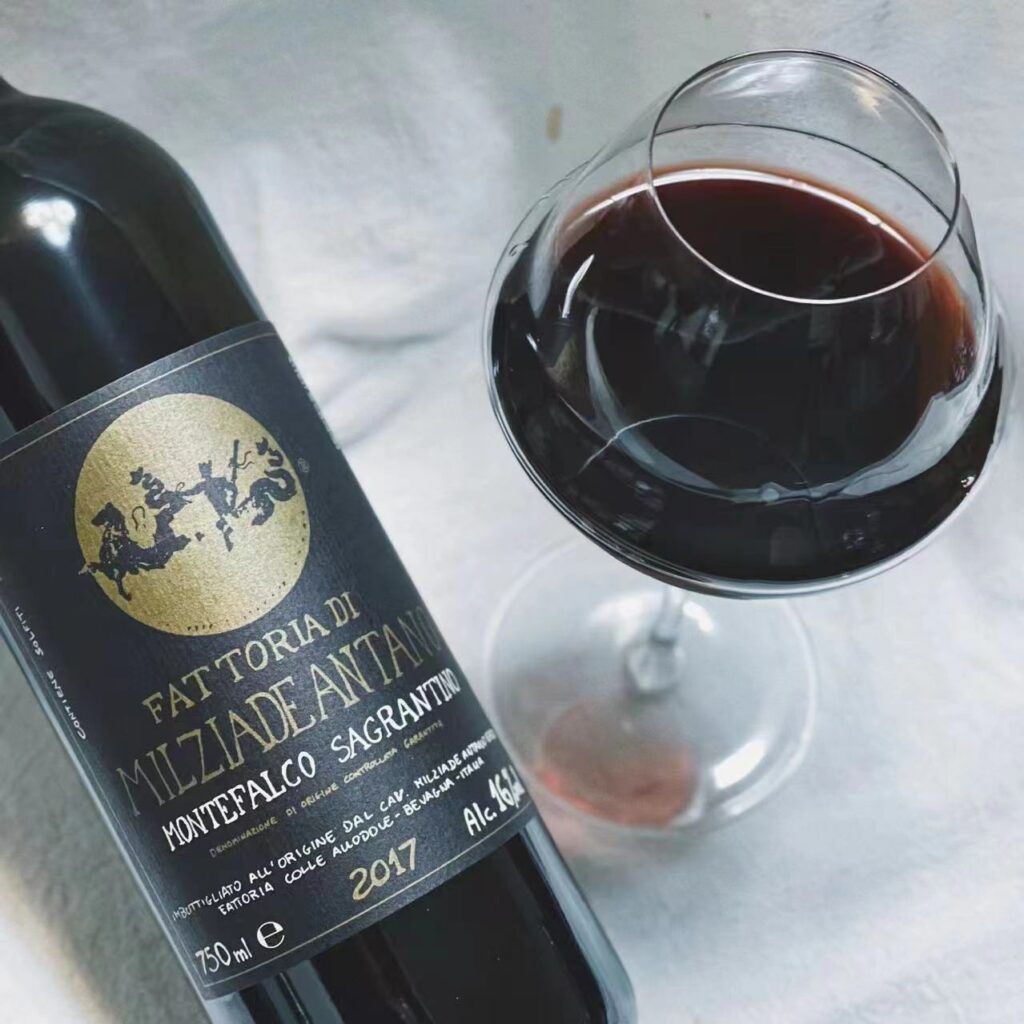
Deep ruby. Perfumed nose of ripe chocolaty dark fruits, forest floor, nutmeg and sandalwood. Rich and ripe on entry, then utterly seamless in the middle palate, with harmonious acidity giving shape and grip to the red berry, earth tone and spice flavors. Finishes savory and long, with building youthfully chewy tannins that leave a mouthcoating impression but one that won’t have you scrambling desperately for something to eat. Drinking window: 2025-2033.
Antano Milziade 2016 Montefalco Sagrantino 95
Bright, saturated ruby-red. Red and dark berries and licorice on the nose, plus perfumed notes of violet and juniper and exotic mocha nuances. Precise and velvety in the mouth, with a glyceral element rounding out the lifted herbal and black fruit flavours. At once thick and alive, thanks to a happy balance of fruity sweetness, ripe tannins and refreshing acidity. Boasts an uncommon balance of thick material, great fruit intensity and vibrant acidity with lingering nuances of grape must, raspberry jam and thyme. Only about 2,500 bottles produced, this is fermented in stainless steel vats using only natural yeasts and is aged 37 months, of which sixteen to eighteen is in large oak casks, and then four to six more in bottle prior to going on sale. Drinking window: 2027-2036.
Antano Milziade 2016 Montefalco Sagrantino Passito 94
Good full red. Tangy, high-toned aromas of red cherry jam, plums macerated in alcohol, orange marmalade and sweet spices, with suggestions of mocha and smoke. Unctuous yet sharply defined and vibrant, thanks to firm acidity buffering the ripe, sweet red fruit and spice flavours. Closes suavely tannic and long, conveying a powerful impression of soil character, not to mention explosive spice and flint nuances. Drinking window: now-2035.
Antonelli.
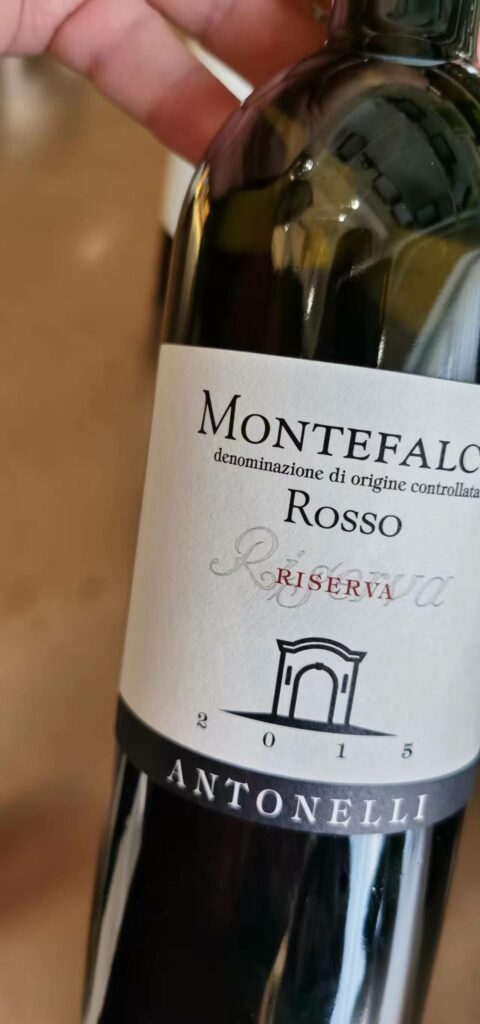
One of the true class acts in Italian wine, Filippo Antonelli has been the best president of the Montefalco consortium ever (and for more than one term too) and also happens to be one of the denomination’s best producers. For sure, he was the first to understand and to show that Sagrantino didn’t need to, and shouldn’t be, mindlessly and needlessly tannic but rather play the cards of perfume and power while remaining light on its feet and refined. One hundred and seventy-five hectares and counting (of which roughly fifty are of vineyards and others devoted to olive groves), clay and limestone-rich soils of various geological origins, different altitudes and exposures, all combine to give wines of varying complexity and diversity. Organic agricultural farming practices, plenty of research and expert winemaking do the rest. The estate also offers an opportunity for wine-tourism by way of its farmhouse called Casale Satriano, carefully restored and decorated that has independent apartments and a swimming pool, even courses on local cuisine. Though I have never been for I only sleep in wineries when on vacation and if I am allowed to pay like everyone else, I can guess that, knowing this estate as well as I do and all it stands for, the stay will prove just grand.
Antonelli 2020 Montefalco Grechetto 90
Bright straw yellow. Subdued aromas of ripe citrus fruits and herbs. Lively and juicy, with precise flavours of herbs and orange peel, plus a distinctly mineral aspect. Finishes medium-long and bright. Drinking window: now-2024.
Antonelli 2019 Montefalco Grechetto 89
Straw yellow in colour. Fresh, fruity and floral with notes of citrus peel, nectarine, and hawthorn blossoms. Then typically Grechetto-good structure in the mouth, and offers pleasantly fresh flavours of almond and orchard fruit, with a clean long afrtertaste. Much better than the muted 2018, which paid the tough year. Made by soft pressing, cold static clarification and fermented and aged in stainless steel tanks. Matches very well with seafood appetiers, cereal soups, and fish-based dishes. Drinking window: now-2-2024.
Antonelli 2019 Trebbiano Spoletino Trebium 90
Lively pale yellow colour. Pear, melon, lemon ice tea, incense and a lavender on the nose. Juicy on entry, then nicely concentrated and rich in extract, with lovely salinity and an edge of lemony acidity that is typical of the variety (even more so when it reminds you of lime). Finishes classically dry and long. From a massal selection of old vine Trebbiano Spoletino. Much better than the disappointing 2018. Drinking window: now-2025.
Antonelli 2019 Trebbiano Spoletino Tonda 91
Good full straw yellow with golden tinges. The nose is at once fruity and floral, with delicate hints of lime, tropical fruit and a hint of white pepper and nutmeg. Offers good clarity and cut thanks to harmonious acidity that nicely frames and extends the stone and orchard fruit flavours on the long suave finisih. This pairs well with cold cuts but also richer dishes such as a carbonara, saffron risotto or fish stews. Trebbiano Spoletino from a massal selection planted facing west at 350 meters above sea level. Antonelli made this wine for the first time in 2007 and I find it has improved by leaps and bounds over the years. Made with a light skin contact maceration, soft pressing, and static cold clarification; fermentation is in large oak barrels. Spends six months on the lees prior to bottling. Drinking window: now-2025.
Antonelli 2016 Montefalco Rosso 92
Good full red. Very expressive nose offers strawberry, red plum, smoke and violet. Bright, smooth and expressive, with ripe red fruit and floral flavours lifted by mineral high notes and nicely framed by suave acids and tannins. Very fine-grained, this is both elegant with a captivating lightty touch. Lots of early pleasure. A blend of 70% Sangiovese, 15% Sagrantino and 15% other red grapes like Merlot, Antonelli first made this wine back in 1979. The grapes are sourced from vines planted between 300 and 400 meters in altitude with a southern and southwesterly exposure. Each variety is vinified separately; skin contact maceration and fermentation last about two to three weeks, then the varieties are blended together and aged for nine months at the very least in large oak barrels. Drinking window: now-2025.
Antonelli 2015 Montefalco Rosso Riserva 91+
Good deep ruby-red. Inviting aromas of red cherry, blackberry and leather, with a whiff of strawberry jam. Supple and rather fine-grained on entry, then slightly tougher in the middle, wth a whiff of pepper and a suggestion of dried fruits lingering nicely on the smooth long finish. Antonelli first made this wine in 1998 and back then it was 70% Sangiovese but that percentage has since risen to 80% beginning with the 2016 vintage. The roughly fifteen years old vineyards are planted at 300 to 400 meters in altitude with a southern and southwesterly exposure. The wine undergoes skin contact maceration and fermentation for about three to four weeks, the varieties are vinified separately and are then blended and aged in large oak barrels for at least eighteen months. Drinking window: 2023-2028.
Antonelli 2016 Montefalco Sagrantino 93
Full bright ruby. Tangy aromas of black cherry, blackberry, violet, camphor and exotic spices. Offers lovely creamy sweetness and pliancy on entry, then ripe and vibrant in the middle, with outstanding clarity of flavour on the firm, youthfully chewy long and refined finish. Aged in large oak barrels for at least eighteen months, then rests in glass-lined cement vats a few months before bottling. Drinking window: now-2030.
Antonelli 2015 Montefalco Sagrantino 92
Deep, bright ruby. Slightly medicinal aromas of redcherry, hibiscus, flint, tobacco and loam. Broad, compellingly sweet and rich, with above average concentration and depth to the flavours of red fruit and herbs. Boasts a tactile texture but a very nimble mouthfeel on the long ripe effusively fruity and mouthcoating finish. Drinking window: now-2030.
Antonelli 2015 Montefalco Sagrantino Passito 93
Saturated ruby. Exotic, liqueur-like nose hurls red berries, oak spices, orange peel, cinnamon, licorice and milk chocolate at you. Lively, sweet and fleshy in the mouth, with an an evolved, ample, but pleasant earthy/floral note that reminded me a bit of some superb Recioto della Valpolicella wines by Quintarelli. Finishes very long, with thoroughly ripe, suave tannins and repeating red cherry and berry flavours. Made from organically certified grapes and aged for about one year in oak, this gorgeous wine was first made by Antonelli back in 1979. Drinking window: now-2028.
Arnaldo Caprai.
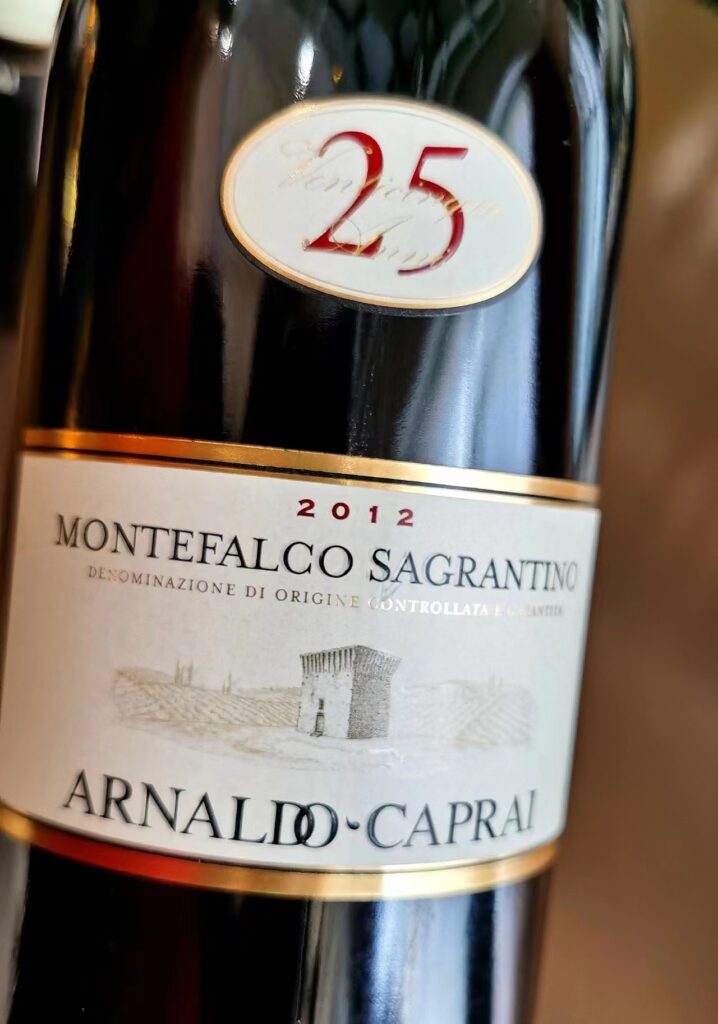
Marco Caprai has done more than possibly anyone else for the Montefalco denomination than any other producer (though clearly Filippo Antonelli of the eponymous estate and Valentino Valentini of the Bocale estate deserve high praise in this respect too). Simply by virtue of his 25 Anni bottling, long the quality benchmark in Sagrantino land, Caprai has done more to shine the spotlight on the denomination, its wines and the grape variety, than anyone else. Marco is also a grat ambassador of his denomination, and he deserves credit for this: I still remember one time I visited the Caprai estate and he selfishlessly took me personally to also visit other estates such as Adanti and Antano Milziade, not realizing I had already met and visited these producers in the past and was either going to see them next or already had done so; no matter, it was fun to go again with him (intelligently, he realizes that if he’s the only one anybody ever talks or writes about, then the denomination and the wine are more or less dead in the water), though I never visit any producer anywhere with another one in tow. The Caprai portfolio of wines, not just the Sagrantino 25 Anni, are always excellently made and sure-fire buys as their regularity and value in each and every vintage is beyond reproach. The estate has also invested heavily in research over the years, which has led not just to all the estate wines being more than just valid (witness the Sagrantino Collepiano, which in many vintages has been the equal if not better -certainly easier to like and drink- than the famous 25 Anni) but also improving by leaps and bounds (witness, again, the Grechetto Grecante, never as good as it has been in the last few vintages). Certainly, the clonal research carried out with the Sagrantino variety has led to the development of interesting new clones such as the Cobra series, aptly named as these are known for their tannic bite.
Arnaldo Caprai 2020 Grechetto Colli Martani Grecante 91
Ok folks, hats off: best Grecante ever from Caprai? If not, it’s second best but I can’t remember for the life of me what vintage was better than this one. A wine that although always well-made and easy-going has never been especially impressive, the 2020 Grecante is poised, taut, concentrated and balanced, not to mention more flavourful than I have memory of. Lime, white flowers, herbs and ripe orchard fruit aromas and flavours will draw you back to you glass again and again. Lovely stuff with a nicely persistent fresh aftertaste. Drinking window: now-2023.
Arnaldo Caprai 2016 Montefalco Rosso 90
Deep ruby-red. Pungently perfumed aromas of black cherry, raspberry, sandalwood and milk chocolate. Then sweet and sappy in the mouth, with nicely delineated flavours of dark cherry and minty herbs. Though not particularly complex, this packs in plenty of flavour, finishing with smooth tannins. Lovely Rosso that punches way above its weight class. Drinking window: now-2025.
Arnaldo Caprai 2015 Montefalco Rosso Riserva 91
Good full ruby. Vibrant aromas of deep black raspberry, licorice and violet. Then nicely expressive in the mouth with youthfully chewy flavours of blackberry, smoke, and spreading out to saturate the palate. Drinking window: now-2025.
Arnaldo Caprai 2013 Montefalco Rosso Riserva 91
Good ruby-red. Captivating aromas of blackberry, toffee, mocha and herbs. Dense, lush and sweet, with the precise fruit flavours lifted by candied violet, mocha and herbs. Offers big structure but also excellent harmony and finishes very suave and very long. Drinking window: now-2024.
Arnaldo Caprai 2016 Montefalco Sagrantino Collepiano 92
Deep ruby purple. Violet, blackberries, mint, dried flowers and cocoa. Then dense and full, with very chewy tough tannins framing black cherry, cracked black pepper and thyme on the nose and in the mouth. Finishes long but mouthcoating, this needs time. Drinking window: 2024-2028.
Arnaldo Caprai 2012 Montefalco Sagrantino 25 Anni Riserva 94
Good saturated ruby. Extremely refined, complex nose of blackberry, cocoa, maple syrup, tobacco and licorice lifted by a bright violet topnote. Dense and aromatic in the mouth, with compelling sweetness and suavity of texture that is uncommon with thios variety. Perhaps not the most concentrated 25 Anni I have ever tasted but magically pure and long with a levity that lingers long on the aftertaste. And in 2012 no less, a year characterized by gritty tannins almost everywhere you turned. Closes seamless and nicely persistent. This bottle was just alittle more advanced and elss dense than nanother I had earlier in the year that I had scored 95 and was featured in a Wines of The Week column in TerroirSense Wine Review earlier this year. Still, this is a beautiful wine. Drinking window: now-2030.
Arnaldo Caprai 2010 Montefalco Sagrantino Spinning Beauty 95
Deep saturated ruby. Crushed blackberry, licorice pastille, violet and a whiff of tar on the nose. Superconcentrated but not over the top, with very big but also very polished tannins, with intense cassis and blackberry fruit flavors complemented by chocolate and menthol. Noteworthy power but refined, this is a gorgeous wine that will take your breath away. The cost will take your breath away too. Drinking window: now-2040.
Bocale.
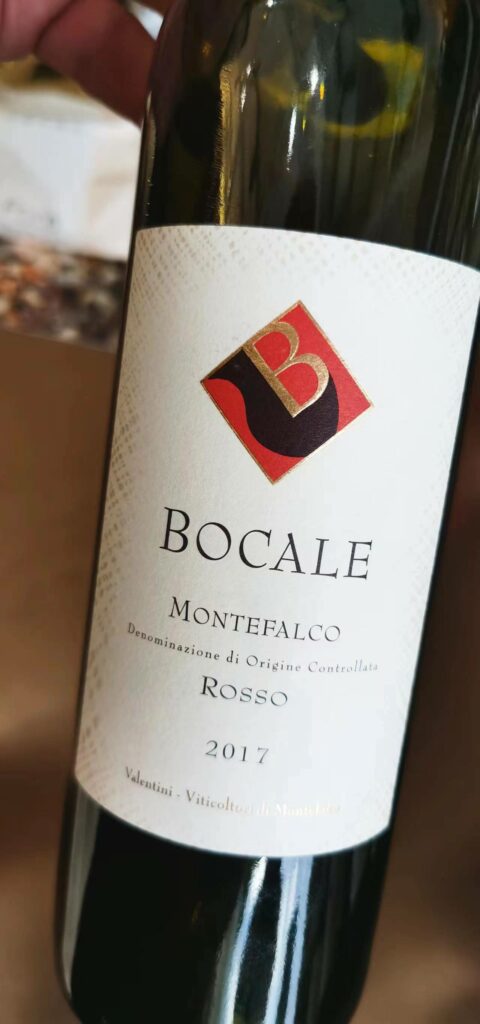
Founded in 2002, but in fact the Valentini family has been involved in Umbrian wine circles for a century. The estate’s name, Bocale, is a longstanding family nickname, but it’s also a reference to the bocale, a two-liter mug of wine or olive oil. The winery farms six hectares of vines producing around 30,000 bottles of wine annually and is run today by Valentino Valentini. The wines have improved by leaps and boudns over the years and they are much better of late than those made in the early years, that like many other Sagrantino wines of the time (especially) were rustic and excessively tannic. Nowadays, these are instead amongst the best wines of the denomination and taking the whole range in account this year, Bocale’s was probably the best performance of all the Montefalco wineries I tried the wines of in 2022. A star is born? Let’s see, but for the moment, well done.
Bocale 2017 Montefalco Rosso 93
Bright ruby-red. Vibrant aromas of red plum, violet and tobacco, complemented by a red cherry nectar note and sweet spices. Suave and sexy wine, at once plush and light on its feet, with outstanding intensity and delineation to its scented flavours of dark berries, sweet scies, herbs, sandalwood and flowers. Finishes long and perfumed, with fine-grained tannins. This is a knockout wine that punches through and beyond the really difficult growing season. A blend of 70% Sangiovese, 15% Sagrantino, 10% Merlot and 5% Colorino aged in used barrels and barriques for about twelve months and then aged in bottle for at least another six months. This was by far the best Montefalco Rosso I tasted this year; not the last word in concentration or complexity, but seamlessly fruity and exceptionally balanced, it’s just a lovely midweight red wine that is as good as many of the better Chianti and Rosso di Montalcino wines you can think of. Well done. Drinking window: now-2025.
Bocale 2015 Montefalco Sagrantino 94
Medium-ruby. Inviting aromas of red and dark plum, menthol, sweet spice, violet and Burgundian earth tones. Lush and sweet in the mouth, with plum, flroal pastille, underbrush and licorice flavours. Harmonious acids give shape to the wine while extending the very pure, suave flavours on the long rising back end. Aged in 1000 liters French oak barrels for twenty-four months and then in bottles for other twelve months. Another knockout wine by Bocale. Drinking window: now-2025.
Bocale 2013 Montefalco Sagrantino Passito 93
Moderately saturated ruby. Mocha and mint buffer the ripely fruity aromas of plum and rsaspberry. Then supple and silky in the mouth, with ripe, sweet flavors of blackberry, strawberry, forest floor, mocha and cloves. Offers very good fruit intensity and vibrancy, suave tannins and plenty of definition on the long impeccably balnced and polite finish. Made with air-dried grapes (for at least two months) and aged oine year in barriques, this is just alovely sweet wine that will match very well with aged and blue cheeses, chocolate goods of all kinds but in fact will do remarkably with a rich beef stew as well (provided there is a sweet element to the sauce). Drinking window: now-2028.
Castelbuono.
The world-famous Lunelli family of Trentodoc fame (the family is one of the absolutely best sparkling wine producers of Italy and the world), purchased the estate and thirty hectares in 2001, and initially focused on the vineyards and various clonal selections of Sagrantino (the vineyard has since undergone organic conversion). Next up was building anew winery and here the family really outdid itself, hiring family friend and world-famous contemporary artist Arnaldo Pomodoro. Pomodor came up with what is essentially a work of art, the so-called “Carapace” (think the outer shell of a crab or any crustacean, but even of a tortoise) that is really something to behold. That much admitted, I’ll say the inside of the winery is pretty impressive too, spacious and luminous. Even better, over the years, the wines have gone from strength to strength.
Castelbuono 2016 Montefalco Sagrantino Carapace 92+
Bright ruby. High-pitched, floral aromas of crushed red berries and plum lifted by a whiff of rose petal. Then juicy and perfumed in the mouth but with good energy to its exotic red berry and flinty flavours. A vertical, lively and very pure wine that boasts lovely clarity and finishing perfume. Drinking window: now-2025.
Castelbuono 2014 Montefalco Sagrantino Passito 92
Deep ruby. Wild aromas of blackberry, cassis, bitter chocolate, maple syrup, and cedar, complicated by hints of orange peel. Then flavours similar to the aromas with a hint of smoky torrefaction but also a layered mouthfeel and a long finish that features reminders of rhubarb, strawberry, ginger and dried orange peel. Drinking window: now-2025.
Fratelli Pardi.
A family involved locally in wine since 1919 as well as other remunerative activities, the brothers Gianluca Rio e Alberto Mario (while the original Pardi brothers were three: Alfredo, Francesco ed Alberto) make wines that are easy to like and often of earlier appeal than many in the denomination. The winery farms eleven hectares in local high-quality subregions around Casale, Pietrauta and Lasignano, among others. These are very dependable wines that rarely disappoint.
Fratelli Pardi 2016 Montefalco Sagrantino 93
Good full ruby. Aromas and flavours of ripe plum, mocha, flint and violet, complicated by hints of mocha and flint. Then luscious dense and juicy, with pretty acidity and cool tannins nicely framing the plush flavours of smoky plums and forest floor on the long close. This estate is always a sure bet when it comes to its Sagrantino wines; amd though I haven’t tried it this year, their Passsito is usually very good too. Drinking wndow: 2023-2028.
Lungarotti.
The Lungarotti family is the name in Umbrian wine, with their historic Rubesco blend being as famous as names like Chianti and Valpolicella, the difference being that Rubesco is a brand name (the wine denomination is actually Torgiano Rosso, where the Lungarotti headquarters are located). In fact, the Montefalco denomination was also created with Lungarotti’s input and so it was only natural for the family to want to have foot there too; and so in 2000 they acquired twenty hectares and began producing the local wines, both red and white, as well as dry and sweet. Like all of Lungarotti’s wines, these are created with the consultant help of star winemaker Lorenzo Landi.
Lungarotti 2017 Montefalco Sagrantino 91
Saturated bright ruby. Aromatically pure but reticent nose offers blackberry, violet, forest floor and cocoa. Deep, concentrated, and chewy, with blackberry and citrus fruit complemented by herbs and cocoa. The building tannins are substantial and speak of the very difficult hot year, in which there really was only so much you could do: so this is currently on the tough side, but there’s enough sweet black fruit hiding beneath to leave me hopeful the fruit will ultimately win out over the tannins. The aftertaste is long and fresh. Drinking window: 2024-2030.
Terre De La Custodia.
Terre De La Custodia 2018 Montefalco Rosso 91
Full ruby. Fresh aromas of red cherry, plum, coffee, sweet spices and licorice. Bright juicy and with fairly plush flavours that offer considerable early appeal. Finishes quite persistent, with ripe, dusty tannins, this is an excellent Montefalco Rosso. Drinking window: now-2025.
Terre De La Custodia 2016 Montefalco Sagrantino 92
Bright red-ruby. Highly perfumed, even pungent aromas of lavender, violet and herbs complicate dark plum and blackberry on the vibrant but ultimately slightly atypical nose; reminiscent of aromatic grapes or whole bunches. Then light and lively in the mouth with the aromatic component repeating and nicely complementing the lively very pretty dark fruit flavours. Very smooth and long, with a light on its feet quality. Finishes with hints of citrus peel and peach. Knockout wine that everybody I have given it to try really liked, with a really singular aromatic note. So what’s not to like? It’s lovely a wine. Drinking window: now-2026.
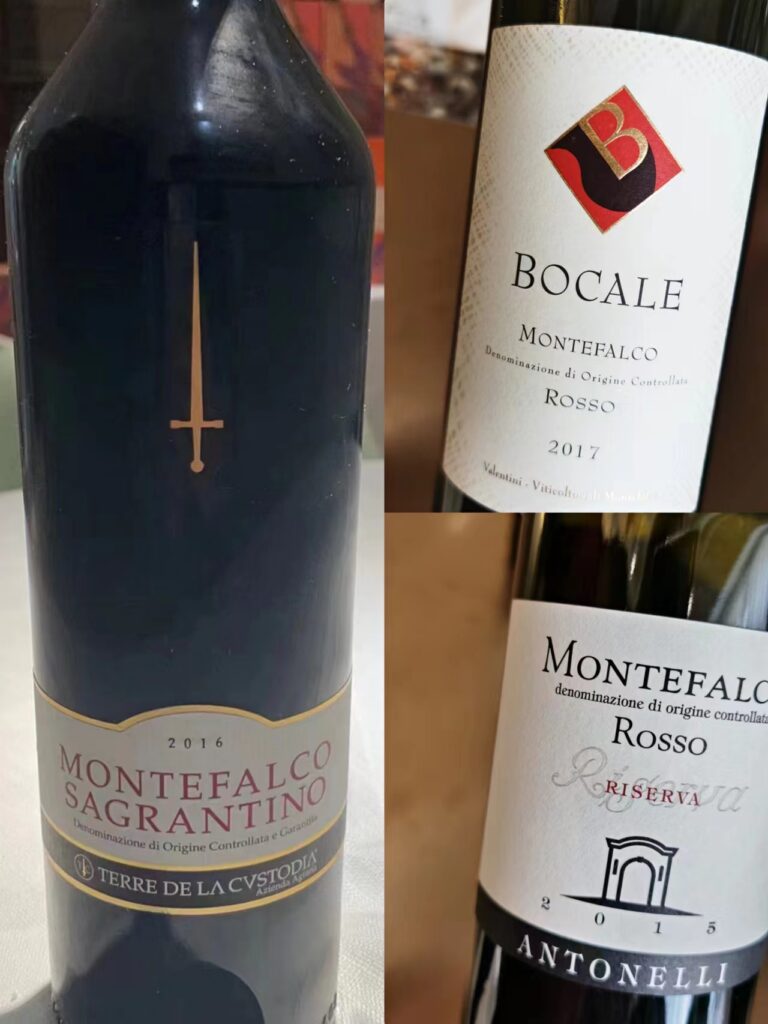

 English
English

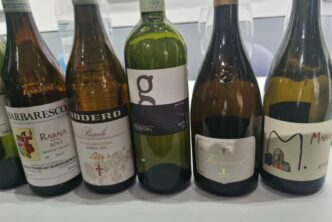

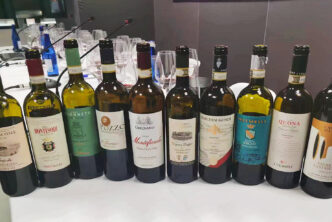
Very nice profile of an under-the-radar area for lovers of Italian wine. I appreciate the analysis of the Montefalco Rosso wines, very enlightening. We had a fabulous visit to Umbria a few years back, and were able to visit Lungarotti and Caprai, both producing very nice wines. We also found another producer, Fongoli, that was making very interesting and high quality Sagrantino, including some in amphorae. And we absolutely fell in love with Spello; it is one of the most charming towns I’ve ever seen. Can’t wait to get back there, and thanks to you I have a few new producers to visit. Grazie mille!
Ciao John, so glad you enjoyed the article. There’s a lot to like about Montefalco wines especially now that the Sagrantino wnes are less massive and tannic than they once were and the other reds have vastly improved. The Passitos have always been great. Thanks and I hope you keep enjoying our Italian wine coverage which is going to be, if it isn’t already second to none in the world. In this light, check out this coming Friday’s rare vertical of a stupendous if little-known Italian white wine.
Si, Si, Certo! Il vino italiano è il mio preferito e i tuoi articoli sono eccellenti.
Grazie per tutto!
Complimenti epr il tuo italiano! Look forward then to upcoming barolo and barbaresco verticals, Etna Rosso verticals, , Sardinian reds and much more, for wat is quite simply the best and most in-depth Italian wine coverage anywhere!
And should you pine for Alsace, Bordeaux, Burgundy, Canadian, German, New Zeland and South African beauties, more verticals coming up from those regions as well, stay tuned!!!!
Hi, Ian As usual no one gets “under the skin” of the grape/wine world the way you do-your surveys of this kind are simply the best. I was curious why the omission of the other sagrantino giant Paolo Bea from the article. I encountered Bea’s wines on a trip to Umbria in the early 2000’s and my wine-drinking life was never the same afterwards. I know they have gotten crazy expensive at least in the US but so have other cultish somm-darlings (Clos Rougeard, Gonon to name two…) Thanks, Tom
Ciao, thanks for this Tom and I have to say I love Paolo Bea’s wines, so the only reason they are not included in this article is because I just didn’t get them by the time the article was due out.
Normally I visit the wineries of the wine regions I cover non-stop all year long, but now with Covid having made travel so difficult I am waiting to start that up again; until then, in the meantime, I have to rely on the wineries either sending me samples or their importers doing so. Unfortunately not all wineries and importers are as good at this, and so sometimes the wines don’t make it into the article. In that case, if and when they do show up on my doorstep then I include them either in a hypothetical part 2 of the article or maybe as a Wines of the Week or a “Miscellaneous” article.
Also, when I am in Europe I actually buy a lot of wines personally out of pocket from wine shops to make my articles more complete and have in fact done so for tons of articles over the years, but clearly now that I live in China that’s not possible anymore for there just may not be all the wines imported into the country or perhaps the latest vintage isn’t yet available here by the time the article has to come out. But I will “fill in the blanks” so to speak, when I get back to France, Italy, Germany or Canada or any other nation I may be writing an article on the wines of. Thanks for your observation,
ian